Business Administration Report: Detailed Unit Examination
VerifiedAdded on 2020/06/04
|27
|6969
|61
Report
AI Summary
This report delves into various aspects of business administration, beginning with an introduction to the field and its core components such as accounting, finance, and marketing. It then explores office management procedures, including establishing efficient policies, system management, and the importance of a positive work environment. The report further examines research methods, differentiating between primary and secondary sources, and quantitative and qualitative approaches, along with data analysis techniques, including parameter analysis and ethical considerations. Additionally, it covers mail security protocols, including identifying suspicious items and handling confidential mail. The report emphasizes the significance of accurate data, effective communication, and organized procedures within a business context, providing a comprehensive overview of key operational and management elements.

BUSINESS
ADMINISTRATION
ADMINISTRATION
Paraphrase This Document
Need a fresh take? Get an instant paraphrase of this document with our AI Paraphraser
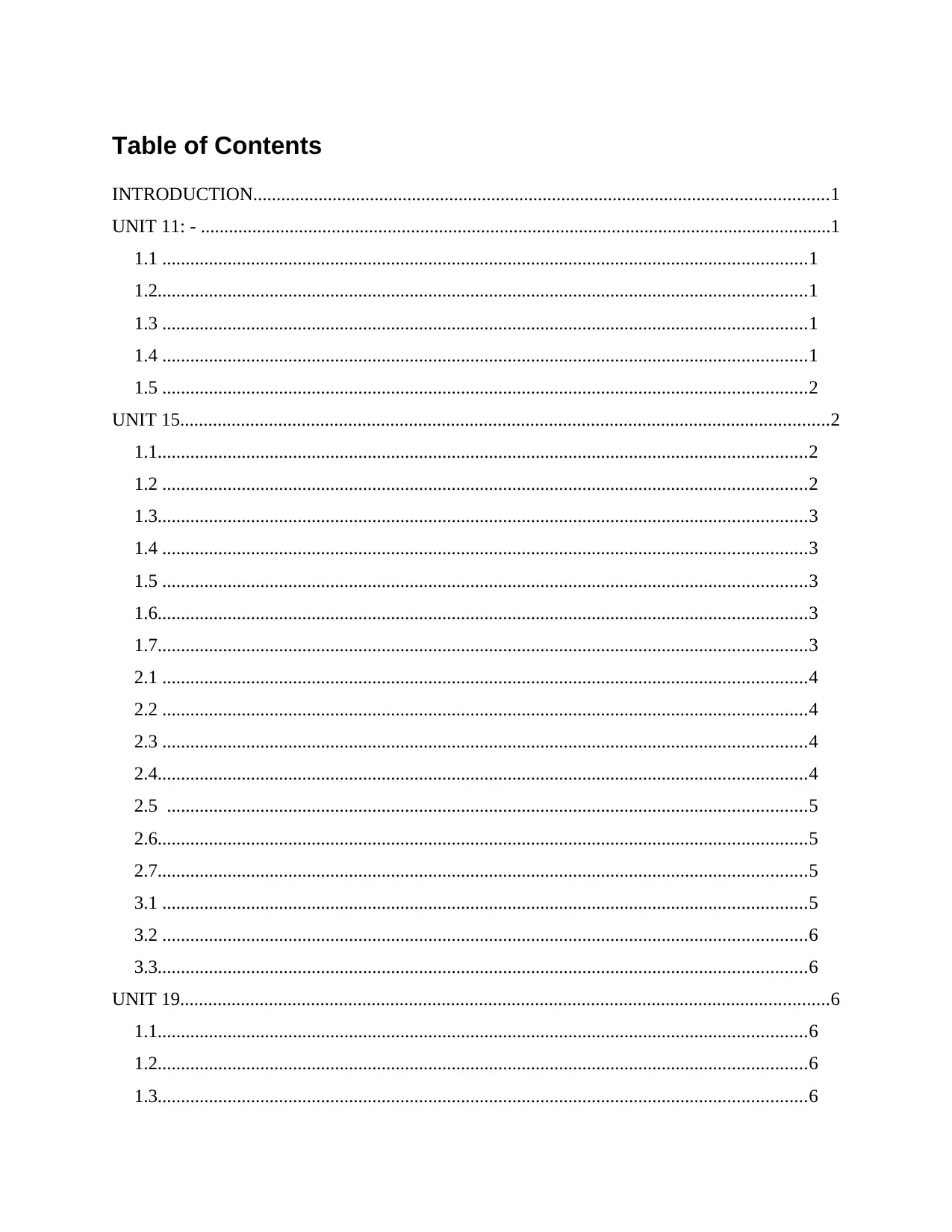
Table of Contents
INTRODUCTION...........................................................................................................................1
UNIT 11: - .......................................................................................................................................1
1.1 ..........................................................................................................................................1
1.2...........................................................................................................................................1
1.3 ..........................................................................................................................................1
1.4 ..........................................................................................................................................1
1.5 ..........................................................................................................................................2
UNIT 15...........................................................................................................................................2
1.1...........................................................................................................................................2
1.2 ..........................................................................................................................................2
1.3...........................................................................................................................................3
1.4 ..........................................................................................................................................3
1.5 ..........................................................................................................................................3
1.6...........................................................................................................................................3
1.7...........................................................................................................................................3
2.1 ..........................................................................................................................................4
2.2 ..........................................................................................................................................4
2.3 ..........................................................................................................................................4
2.4...........................................................................................................................................4
2.5 .........................................................................................................................................5
2.6...........................................................................................................................................5
2.7...........................................................................................................................................5
3.1 ..........................................................................................................................................5
3.2 ..........................................................................................................................................6
3.3...........................................................................................................................................6
UNIT 19...........................................................................................................................................6
1.1...........................................................................................................................................6
1.2...........................................................................................................................................6
1.3...........................................................................................................................................6
INTRODUCTION...........................................................................................................................1
UNIT 11: - .......................................................................................................................................1
1.1 ..........................................................................................................................................1
1.2...........................................................................................................................................1
1.3 ..........................................................................................................................................1
1.4 ..........................................................................................................................................1
1.5 ..........................................................................................................................................2
UNIT 15...........................................................................................................................................2
1.1...........................................................................................................................................2
1.2 ..........................................................................................................................................2
1.3...........................................................................................................................................3
1.4 ..........................................................................................................................................3
1.5 ..........................................................................................................................................3
1.6...........................................................................................................................................3
1.7...........................................................................................................................................3
2.1 ..........................................................................................................................................4
2.2 ..........................................................................................................................................4
2.3 ..........................................................................................................................................4
2.4...........................................................................................................................................4
2.5 .........................................................................................................................................5
2.6...........................................................................................................................................5
2.7...........................................................................................................................................5
3.1 ..........................................................................................................................................5
3.2 ..........................................................................................................................................6
3.3...........................................................................................................................................6
UNIT 19...........................................................................................................................................6
1.1...........................................................................................................................................6
1.2...........................................................................................................................................6
1.3...........................................................................................................................................6
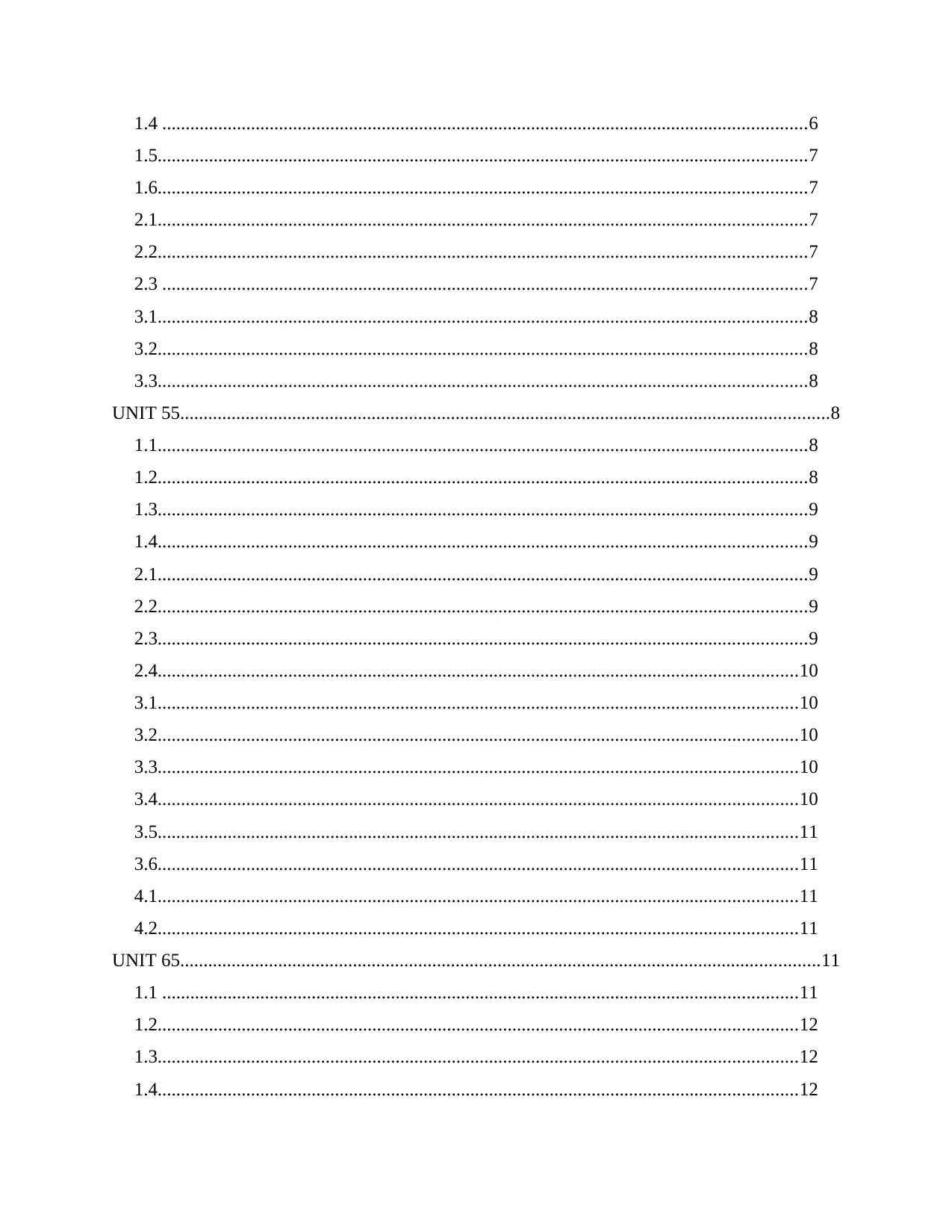
1.4 ..........................................................................................................................................6
1.5...........................................................................................................................................7
1.6...........................................................................................................................................7
2.1...........................................................................................................................................7
2.2...........................................................................................................................................7
2.3 ..........................................................................................................................................7
3.1...........................................................................................................................................8
3.2...........................................................................................................................................8
3.3...........................................................................................................................................8
UNIT 55...........................................................................................................................................8
1.1...........................................................................................................................................8
1.2...........................................................................................................................................8
1.3...........................................................................................................................................9
1.4...........................................................................................................................................9
2.1...........................................................................................................................................9
2.2...........................................................................................................................................9
2.3...........................................................................................................................................9
2.4.........................................................................................................................................10
3.1.........................................................................................................................................10
3.2.........................................................................................................................................10
3.3.........................................................................................................................................10
3.4.........................................................................................................................................10
3.5.........................................................................................................................................11
3.6.........................................................................................................................................11
4.1.........................................................................................................................................11
4.2.........................................................................................................................................11
UNIT 65.........................................................................................................................................11
1.1 ........................................................................................................................................11
1.2.........................................................................................................................................12
1.3.........................................................................................................................................12
1.4.........................................................................................................................................12
1.5...........................................................................................................................................7
1.6...........................................................................................................................................7
2.1...........................................................................................................................................7
2.2...........................................................................................................................................7
2.3 ..........................................................................................................................................7
3.1...........................................................................................................................................8
3.2...........................................................................................................................................8
3.3...........................................................................................................................................8
UNIT 55...........................................................................................................................................8
1.1...........................................................................................................................................8
1.2...........................................................................................................................................8
1.3...........................................................................................................................................9
1.4...........................................................................................................................................9
2.1...........................................................................................................................................9
2.2...........................................................................................................................................9
2.3...........................................................................................................................................9
2.4.........................................................................................................................................10
3.1.........................................................................................................................................10
3.2.........................................................................................................................................10
3.3.........................................................................................................................................10
3.4.........................................................................................................................................10
3.5.........................................................................................................................................11
3.6.........................................................................................................................................11
4.1.........................................................................................................................................11
4.2.........................................................................................................................................11
UNIT 65.........................................................................................................................................11
1.1 ........................................................................................................................................11
1.2.........................................................................................................................................12
1.3.........................................................................................................................................12
1.4.........................................................................................................................................12
⊘ This is a preview!⊘
Do you want full access?
Subscribe today to unlock all pages.

Trusted by 1+ million students worldwide
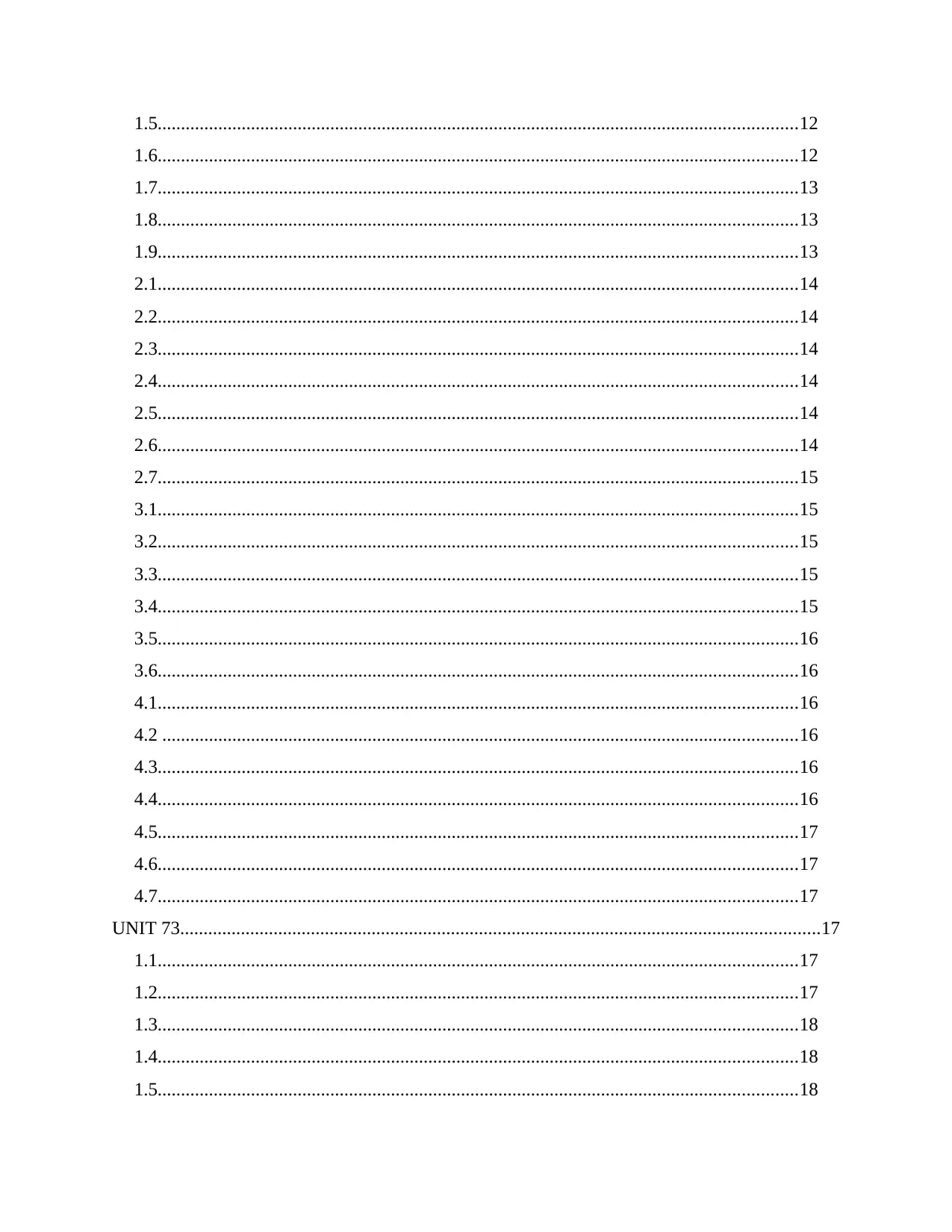
1.5.........................................................................................................................................12
1.6.........................................................................................................................................12
1.7.........................................................................................................................................13
1.8.........................................................................................................................................13
1.9.........................................................................................................................................13
2.1.........................................................................................................................................14
2.2.........................................................................................................................................14
2.3.........................................................................................................................................14
2.4.........................................................................................................................................14
2.5.........................................................................................................................................14
2.6.........................................................................................................................................14
2.7.........................................................................................................................................15
3.1.........................................................................................................................................15
3.2.........................................................................................................................................15
3.3.........................................................................................................................................15
3.4.........................................................................................................................................15
3.5.........................................................................................................................................16
3.6.........................................................................................................................................16
4.1.........................................................................................................................................16
4.2 ........................................................................................................................................16
4.3.........................................................................................................................................16
4.4.........................................................................................................................................16
4.5.........................................................................................................................................17
4.6.........................................................................................................................................17
4.7.........................................................................................................................................17
UNIT 73.........................................................................................................................................17
1.1.........................................................................................................................................17
1.2.........................................................................................................................................17
1.3.........................................................................................................................................18
1.4.........................................................................................................................................18
1.5.........................................................................................................................................18
1.6.........................................................................................................................................12
1.7.........................................................................................................................................13
1.8.........................................................................................................................................13
1.9.........................................................................................................................................13
2.1.........................................................................................................................................14
2.2.........................................................................................................................................14
2.3.........................................................................................................................................14
2.4.........................................................................................................................................14
2.5.........................................................................................................................................14
2.6.........................................................................................................................................14
2.7.........................................................................................................................................15
3.1.........................................................................................................................................15
3.2.........................................................................................................................................15
3.3.........................................................................................................................................15
3.4.........................................................................................................................................15
3.5.........................................................................................................................................16
3.6.........................................................................................................................................16
4.1.........................................................................................................................................16
4.2 ........................................................................................................................................16
4.3.........................................................................................................................................16
4.4.........................................................................................................................................16
4.5.........................................................................................................................................17
4.6.........................................................................................................................................17
4.7.........................................................................................................................................17
UNIT 73.........................................................................................................................................17
1.1.........................................................................................................................................17
1.2.........................................................................................................................................17
1.3.........................................................................................................................................18
1.4.........................................................................................................................................18
1.5.........................................................................................................................................18
Paraphrase This Document
Need a fresh take? Get an instant paraphrase of this document with our AI Paraphraser

1.6.........................................................................................................................................18
2.1.........................................................................................................................................18
2.2.........................................................................................................................................18
2.3.........................................................................................................................................19
3.1 ........................................................................................................................................19
3.2.........................................................................................................................................19
3.3.........................................................................................................................................20
3.4.........................................................................................................................................20
3.5.........................................................................................................................................20
3.6.........................................................................................................................................20
4.1 ........................................................................................................................................20
4.2.........................................................................................................................................20
4.3.........................................................................................................................................21
4.4.........................................................................................................................................21
4.5.........................................................................................................................................21
4.6.........................................................................................................................................21
CONCLUSION..............................................................................................................................21
REFERENCES..............................................................................................................................22
2.1.........................................................................................................................................18
2.2.........................................................................................................................................18
2.3.........................................................................................................................................19
3.1 ........................................................................................................................................19
3.2.........................................................................................................................................19
3.3.........................................................................................................................................20
3.4.........................................................................................................................................20
3.5.........................................................................................................................................20
3.6.........................................................................................................................................20
4.1 ........................................................................................................................................20
4.2.........................................................................................................................................20
4.3.........................................................................................................................................21
4.4.........................................................................................................................................21
4.5.........................................................................................................................................21
4.6.........................................................................................................................................21
CONCLUSION..............................................................................................................................21
REFERENCES..............................................................................................................................22
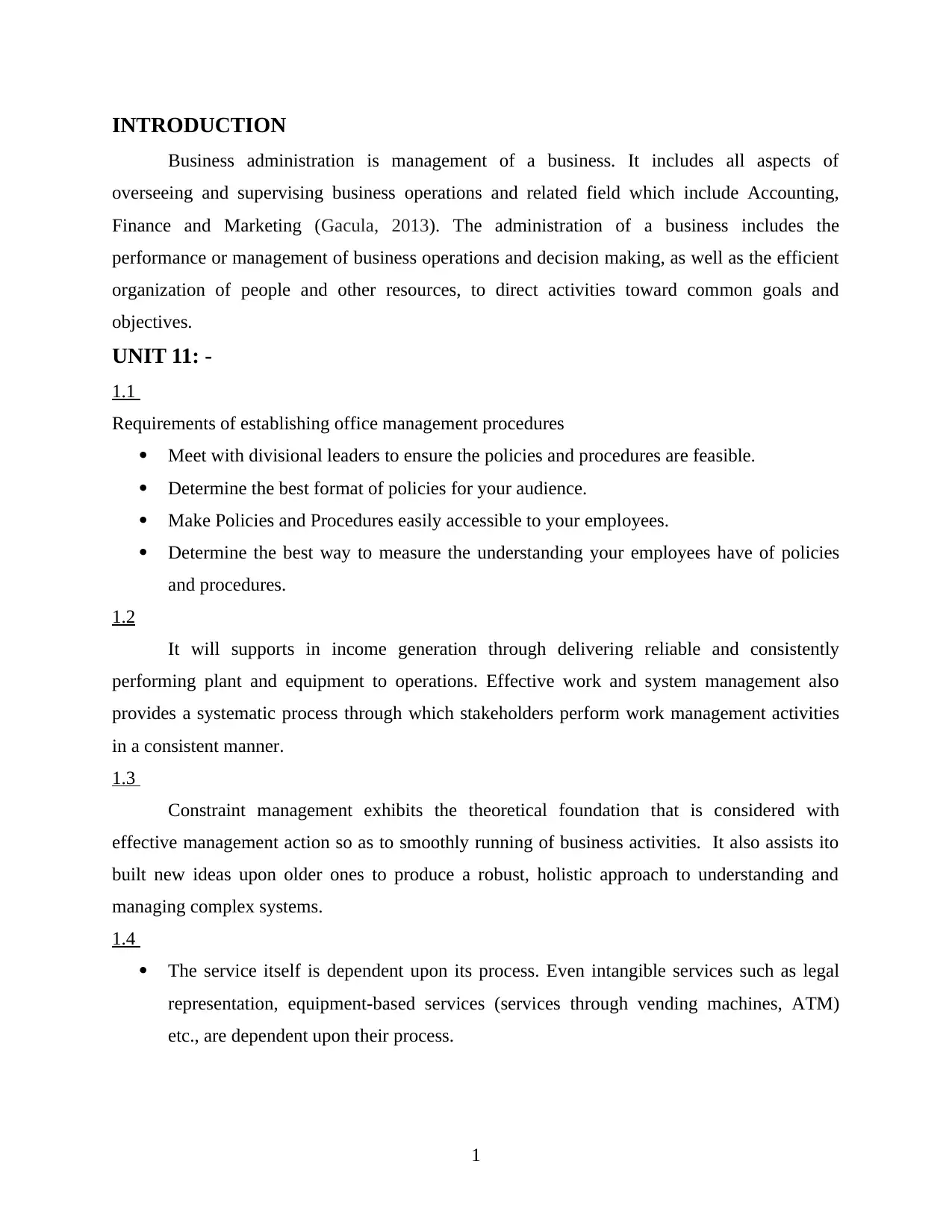
INTRODUCTION
Business administration is management of a business. It includes all aspects of
overseeing and supervising business operations and related field which include Accounting,
Finance and Marketing (Gacula, 2013). The administration of a business includes the
performance or management of business operations and decision making, as well as the efficient
organization of people and other resources, to direct activities toward common goals and
objectives.
UNIT 11: -
1.1
Requirements of establishing office management procedures
Meet with divisional leaders to ensure the policies and procedures are feasible.
Determine the best format of policies for your audience.
Make Policies and Procedures easily accessible to your employees.
Determine the best way to measure the understanding your employees have of policies
and procedures.
1.2
It will supports in income generation through delivering reliable and consistently
performing plant and equipment to operations. Effective work and system management also
provides a systematic process through which stakeholders perform work management activities
in a consistent manner.
1.3
Constraint management exhibits the theoretical foundation that is considered with
effective management action so as to smoothly running of business activities. It also assists ito
built new ideas upon older ones to produce a robust, holistic approach to understanding and
managing complex systems.
1.4
The service itself is dependent upon its process. Even intangible services such as legal
representation, equipment-based services (services through vending machines, ATM)
etc., are dependent upon their process.
1
Business administration is management of a business. It includes all aspects of
overseeing and supervising business operations and related field which include Accounting,
Finance and Marketing (Gacula, 2013). The administration of a business includes the
performance or management of business operations and decision making, as well as the efficient
organization of people and other resources, to direct activities toward common goals and
objectives.
UNIT 11: -
1.1
Requirements of establishing office management procedures
Meet with divisional leaders to ensure the policies and procedures are feasible.
Determine the best format of policies for your audience.
Make Policies and Procedures easily accessible to your employees.
Determine the best way to measure the understanding your employees have of policies
and procedures.
1.2
It will supports in income generation through delivering reliable and consistently
performing plant and equipment to operations. Effective work and system management also
provides a systematic process through which stakeholders perform work management activities
in a consistent manner.
1.3
Constraint management exhibits the theoretical foundation that is considered with
effective management action so as to smoothly running of business activities. It also assists ito
built new ideas upon older ones to produce a robust, holistic approach to understanding and
managing complex systems.
1.4
The service itself is dependent upon its process. Even intangible services such as legal
representation, equipment-based services (services through vending machines, ATM)
etc., are dependent upon their process.
1
⊘ This is a preview!⊘
Do you want full access?
Subscribe today to unlock all pages.

Trusted by 1+ million students worldwide
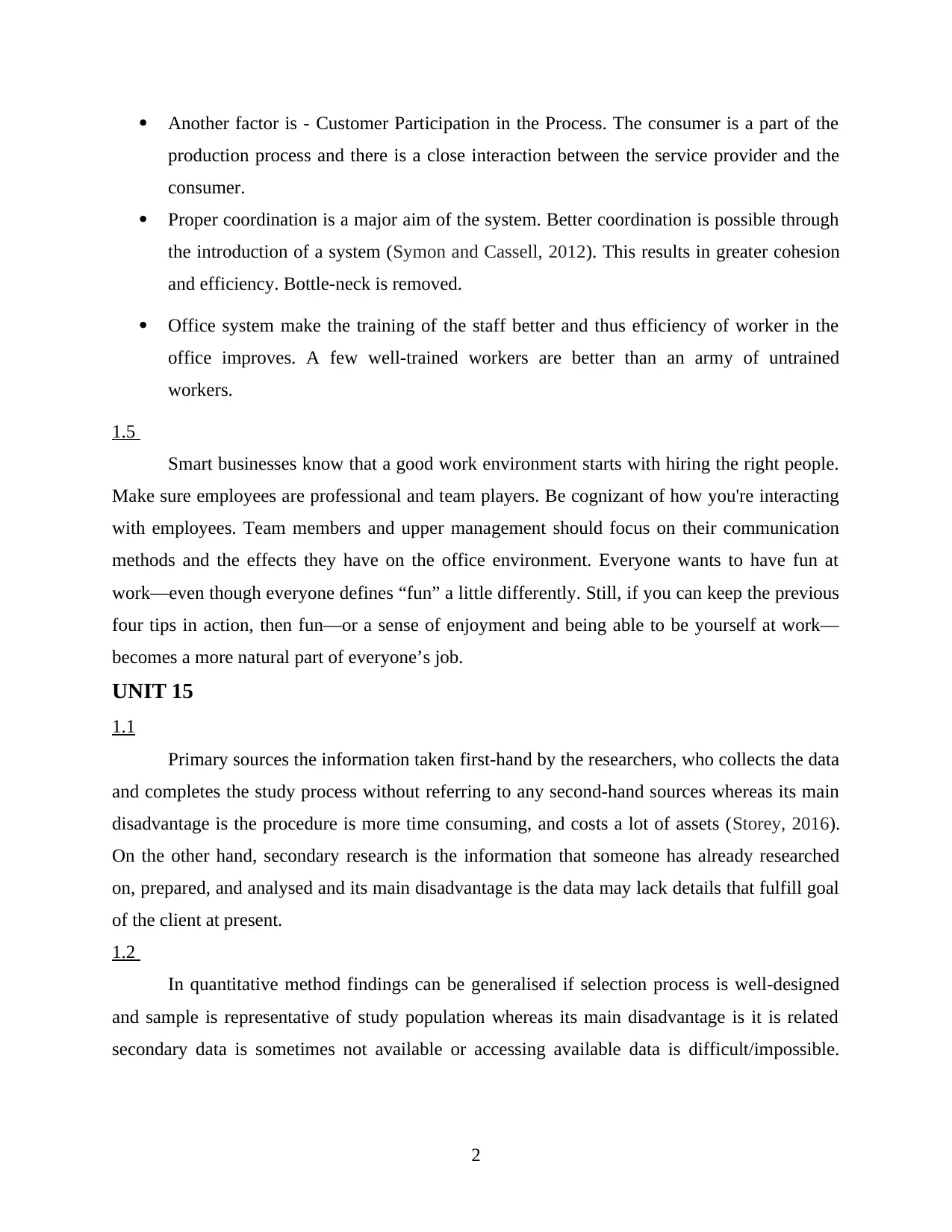
Another factor is - Customer Participation in the Process. The consumer is a part of the
production process and there is a close interaction between the service provider and the
consumer.
Proper coordination is a major aim of the system. Better coordination is possible through
the introduction of a system (Symon and Cassell, 2012). This results in greater cohesion
and efficiency. Bottle-neck is removed.
Office system make the training of the staff better and thus efficiency of worker in the
office improves. A few well-trained workers are better than an army of untrained
workers.
1.5
Smart businesses know that a good work environment starts with hiring the right people.
Make sure employees are professional and team players. Be cognizant of how you're interacting
with employees. Team members and upper management should focus on their communication
methods and the effects they have on the office environment. Everyone wants to have fun at
work—even though everyone defines “fun” a little differently. Still, if you can keep the previous
four tips in action, then fun—or a sense of enjoyment and being able to be yourself at work—
becomes a more natural part of everyone’s job.
UNIT 15
1.1
Primary sources the information taken first-hand by the researchers, who collects the data
and completes the study process without referring to any second-hand sources whereas its main
disadvantage is the procedure is more time consuming, and costs a lot of assets (Storey, 2016).
On the other hand, secondary research is the information that someone has already researched
on, prepared, and analysed and its main disadvantage is the data may lack details that fulfill goal
of the client at present.
1.2
In quantitative method findings can be generalised if selection process is well-designed
and sample is representative of study population whereas its main disadvantage is it is related
secondary data is sometimes not available or accessing available data is difficult/impossible.
2
production process and there is a close interaction between the service provider and the
consumer.
Proper coordination is a major aim of the system. Better coordination is possible through
the introduction of a system (Symon and Cassell, 2012). This results in greater cohesion
and efficiency. Bottle-neck is removed.
Office system make the training of the staff better and thus efficiency of worker in the
office improves. A few well-trained workers are better than an army of untrained
workers.
1.5
Smart businesses know that a good work environment starts with hiring the right people.
Make sure employees are professional and team players. Be cognizant of how you're interacting
with employees. Team members and upper management should focus on their communication
methods and the effects they have on the office environment. Everyone wants to have fun at
work—even though everyone defines “fun” a little differently. Still, if you can keep the previous
four tips in action, then fun—or a sense of enjoyment and being able to be yourself at work—
becomes a more natural part of everyone’s job.
UNIT 15
1.1
Primary sources the information taken first-hand by the researchers, who collects the data
and completes the study process without referring to any second-hand sources whereas its main
disadvantage is the procedure is more time consuming, and costs a lot of assets (Storey, 2016).
On the other hand, secondary research is the information that someone has already researched
on, prepared, and analysed and its main disadvantage is the data may lack details that fulfill goal
of the client at present.
1.2
In quantitative method findings can be generalised if selection process is well-designed
and sample is representative of study population whereas its main disadvantage is it is related
secondary data is sometimes not available or accessing available data is difficult/impossible.
2
Paraphrase This Document
Need a fresh take? Get an instant paraphrase of this document with our AI Paraphraser

Apart from this, qualitative method provides more detailed information to explain complex
issues whereas the process of collection is usually time consuming.
1.3
Research Validity consists with the problem of data gathering represents several concepts
that to the non-researcher may be quite complex. But basically validity boils down to whether the
research is really measuring what it claims to be measuring. On the other hand, Research
Reliability relates to whether research results can be applied to a wider group than those who
took part in a study.
1.4
Research tools and software enable researchers to construct theories and system models.
They typically support capturing hypotheses, inferring mechanisms, and formulating
experimental results within the same framework (Schiederig, Tietze and Herstatt, 2012).
1.5
Sampling risk is one of the many types of risks an auditor may face when performing the
necessary procedure of audit sampling. Audit sampling exists because of the impractical and
costly effects of examining all or 100% of a client's records or books.
1.6
The problem generalisation occurs more often than you might think. People want their
results instantly; they don’t want to wait for them, so well-planned surveys and experiments take
a back seat to instant Web surveys and convenience samples.
1.7
Main types of data analysis presentations are stated as under: -
Time Series Data
Bar Charts
Combo Charts
Pie Charts
Tables
Geo Map
Scorecard
Scatter Charts
Bullet Charts
3
issues whereas the process of collection is usually time consuming.
1.3
Research Validity consists with the problem of data gathering represents several concepts
that to the non-researcher may be quite complex. But basically validity boils down to whether the
research is really measuring what it claims to be measuring. On the other hand, Research
Reliability relates to whether research results can be applied to a wider group than those who
took part in a study.
1.4
Research tools and software enable researchers to construct theories and system models.
They typically support capturing hypotheses, inferring mechanisms, and formulating
experimental results within the same framework (Schiederig, Tietze and Herstatt, 2012).
1.5
Sampling risk is one of the many types of risks an auditor may face when performing the
necessary procedure of audit sampling. Audit sampling exists because of the impractical and
costly effects of examining all or 100% of a client's records or books.
1.6
The problem generalisation occurs more often than you might think. People want their
results instantly; they don’t want to wait for them, so well-planned surveys and experiments take
a back seat to instant Web surveys and convenience samples.
1.7
Main types of data analysis presentations are stated as under: -
Time Series Data
Bar Charts
Combo Charts
Pie Charts
Tables
Geo Map
Scorecard
Scatter Charts
Bullet Charts
3
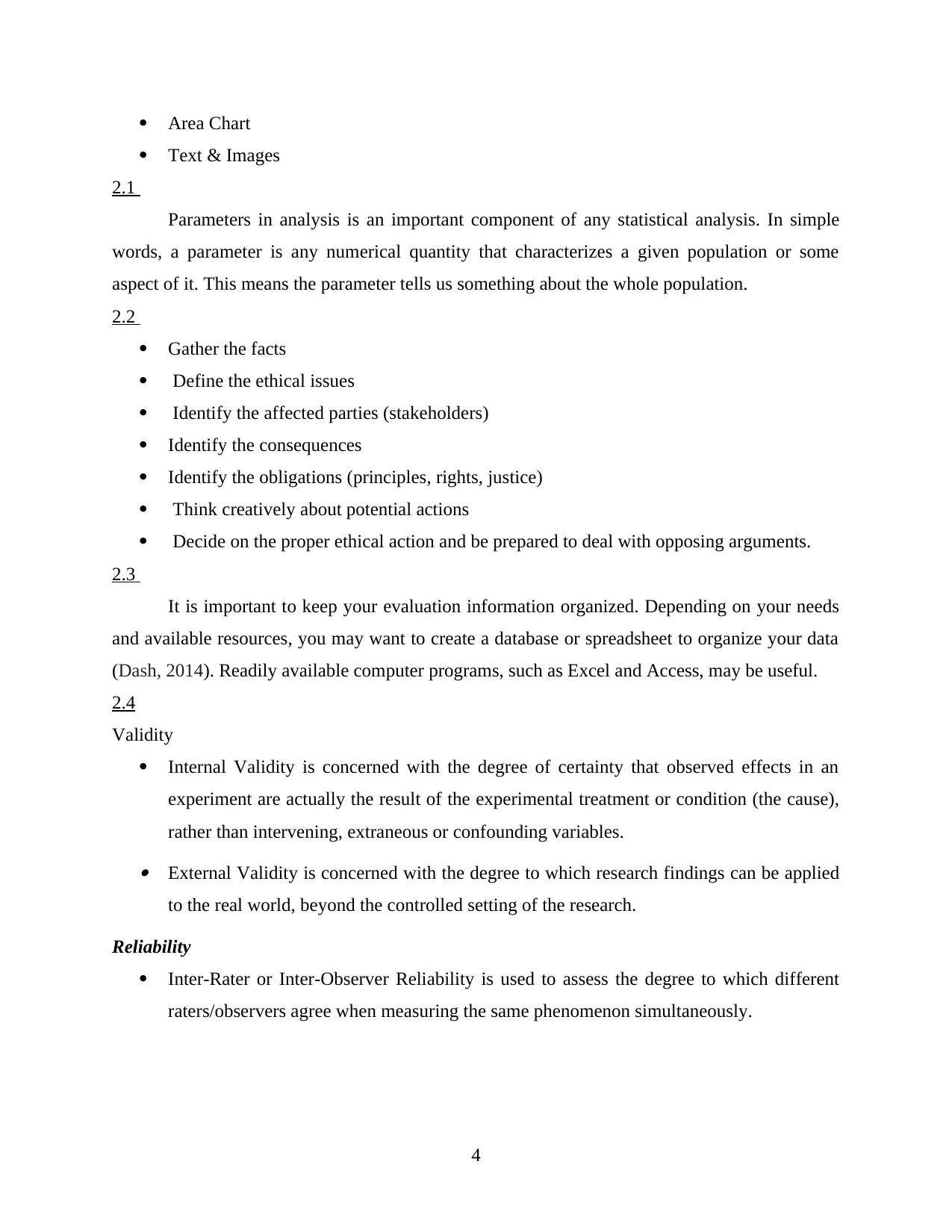
Area Chart
Text & Images
2.1
Parameters in analysis is an important component of any statistical analysis. In simple
words, a parameter is any numerical quantity that characterizes a given population or some
aspect of it. This means the parameter tells us something about the whole population.
2.2
Gather the facts
Define the ethical issues
Identify the affected parties (stakeholders)
Identify the consequences
Identify the obligations (principles, rights, justice)
Think creatively about potential actions
Decide on the proper ethical action and be prepared to deal with opposing arguments.
2.3
It is important to keep your evaluation information organized. Depending on your needs
and available resources, you may want to create a database or spreadsheet to organize your data
(Dash, 2014). Readily available computer programs, such as Excel and Access, may be useful.
2.4
Validity
Internal Validity is concerned with the degree of certainty that observed effects in an
experiment are actually the result of the experimental treatment or condition (the cause),
rather than intervening, extraneous or confounding variables. External Validity is concerned with the degree to which research findings can be applied
to the real world, beyond the controlled setting of the research.
Reliability
Inter-Rater or Inter-Observer Reliability is used to assess the degree to which different
raters/observers agree when measuring the same phenomenon simultaneously.
4
Text & Images
2.1
Parameters in analysis is an important component of any statistical analysis. In simple
words, a parameter is any numerical quantity that characterizes a given population or some
aspect of it. This means the parameter tells us something about the whole population.
2.2
Gather the facts
Define the ethical issues
Identify the affected parties (stakeholders)
Identify the consequences
Identify the obligations (principles, rights, justice)
Think creatively about potential actions
Decide on the proper ethical action and be prepared to deal with opposing arguments.
2.3
It is important to keep your evaluation information organized. Depending on your needs
and available resources, you may want to create a database or spreadsheet to organize your data
(Dash, 2014). Readily available computer programs, such as Excel and Access, may be useful.
2.4
Validity
Internal Validity is concerned with the degree of certainty that observed effects in an
experiment are actually the result of the experimental treatment or condition (the cause),
rather than intervening, extraneous or confounding variables. External Validity is concerned with the degree to which research findings can be applied
to the real world, beyond the controlled setting of the research.
Reliability
Inter-Rater or Inter-Observer Reliability is used to assess the degree to which different
raters/observers agree when measuring the same phenomenon simultaneously.
4
⊘ This is a preview!⊘
Do you want full access?
Subscribe today to unlock all pages.

Trusted by 1+ million students worldwide
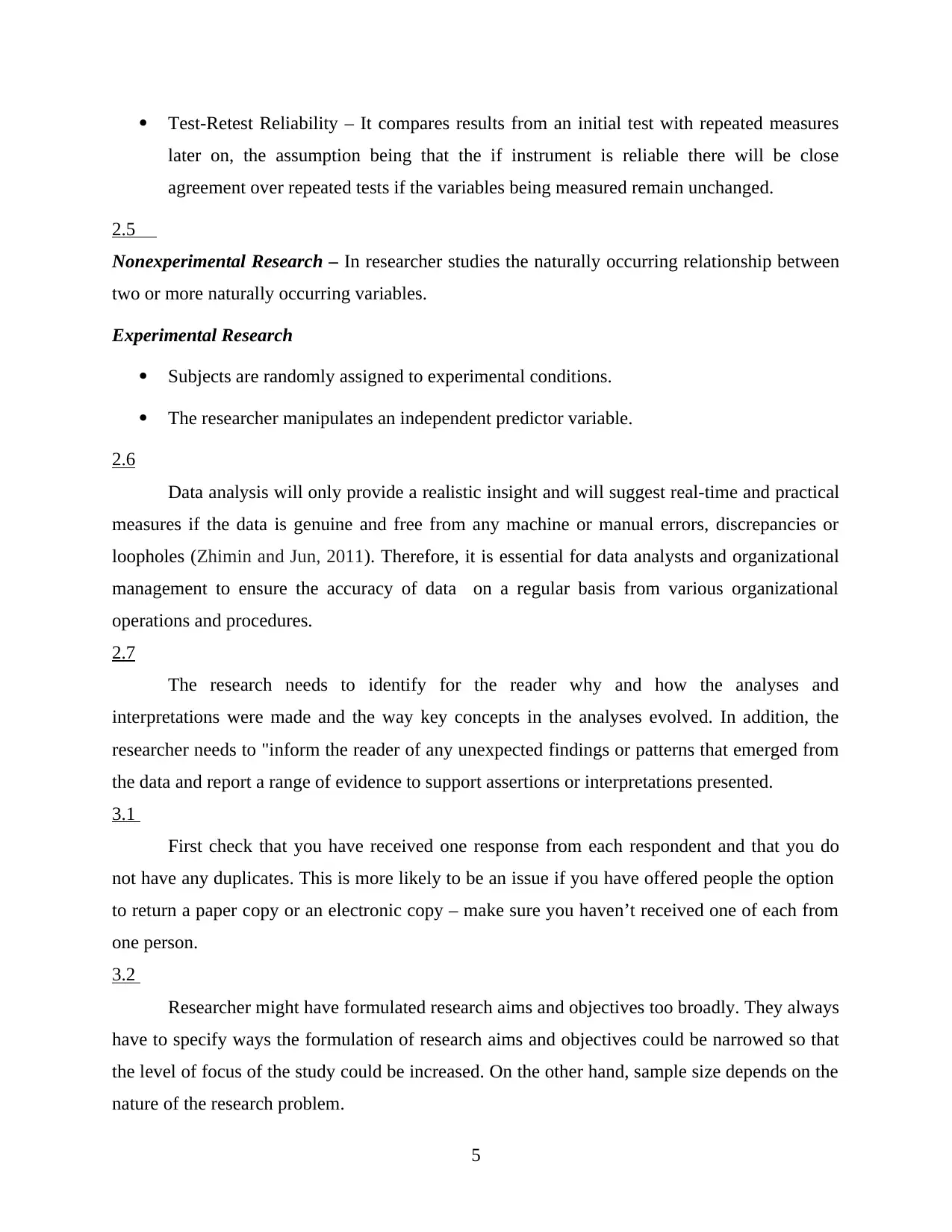
Test-Retest Reliability – It compares results from an initial test with repeated measures
later on, the assumption being that the if instrument is reliable there will be close
agreement over repeated tests if the variables being measured remain unchanged.
2.5
Nonexperimental Research – In researcher studies the naturally occurring relationship between
two or more naturally occurring variables.
Experimental Research
Subjects are randomly assigned to experimental conditions.
The researcher manipulates an independent predictor variable.
2.6
Data analysis will only provide a realistic insight and will suggest real-time and practical
measures if the data is genuine and free from any machine or manual errors, discrepancies or
loopholes (Zhimin and Jun, 2011). Therefore, it is essential for data analysts and organizational
management to ensure the accuracy of data on a regular basis from various organizational
operations and procedures.
2.7
The research needs to identify for the reader why and how the analyses and
interpretations were made and the way key concepts in the analyses evolved. In addition, the
researcher needs to "inform the reader of any unexpected findings or patterns that emerged from
the data and report a range of evidence to support assertions or interpretations presented.
3.1
First check that you have received one response from each respondent and that you do
not have any duplicates. This is more likely to be an issue if you have offered people the option
to return a paper copy or an electronic copy – make sure you haven’t received one of each from
one person.
3.2
Researcher might have formulated research aims and objectives too broadly. They always
have to specify ways the formulation of research aims and objectives could be narrowed so that
the level of focus of the study could be increased. On the other hand, sample size depends on the
nature of the research problem.
5
later on, the assumption being that the if instrument is reliable there will be close
agreement over repeated tests if the variables being measured remain unchanged.
2.5
Nonexperimental Research – In researcher studies the naturally occurring relationship between
two or more naturally occurring variables.
Experimental Research
Subjects are randomly assigned to experimental conditions.
The researcher manipulates an independent predictor variable.
2.6
Data analysis will only provide a realistic insight and will suggest real-time and practical
measures if the data is genuine and free from any machine or manual errors, discrepancies or
loopholes (Zhimin and Jun, 2011). Therefore, it is essential for data analysts and organizational
management to ensure the accuracy of data on a regular basis from various organizational
operations and procedures.
2.7
The research needs to identify for the reader why and how the analyses and
interpretations were made and the way key concepts in the analyses evolved. In addition, the
researcher needs to "inform the reader of any unexpected findings or patterns that emerged from
the data and report a range of evidence to support assertions or interpretations presented.
3.1
First check that you have received one response from each respondent and that you do
not have any duplicates. This is more likely to be an issue if you have offered people the option
to return a paper copy or an electronic copy – make sure you haven’t received one of each from
one person.
3.2
Researcher might have formulated research aims and objectives too broadly. They always
have to specify ways the formulation of research aims and objectives could be narrowed so that
the level of focus of the study could be increased. On the other hand, sample size depends on the
nature of the research problem.
5
Paraphrase This Document
Need a fresh take? Get an instant paraphrase of this document with our AI Paraphraser
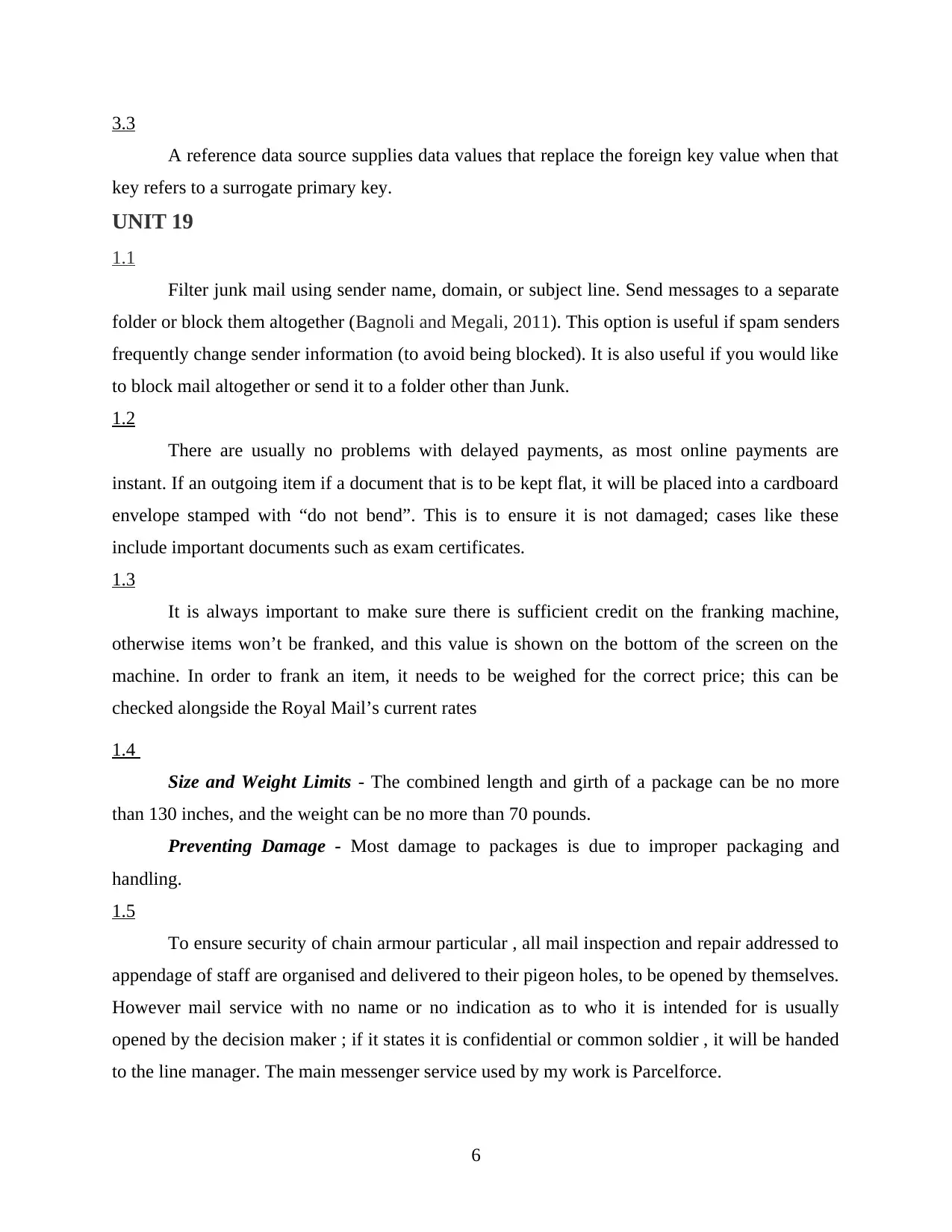
3.3
A reference data source supplies data values that replace the foreign key value when that
key refers to a surrogate primary key.
UNIT 19
1.1
Filter junk mail using sender name, domain, or subject line. Send messages to a separate
folder or block them altogether (Bagnoli and Megali, 2011). This option is useful if spam senders
frequently change sender information (to avoid being blocked). It is also useful if you would like
to block mail altogether or send it to a folder other than Junk.
1.2
There are usually no problems with delayed payments, as most online payments are
instant. If an outgoing item if a document that is to be kept flat, it will be placed into a cardboard
envelope stamped with “do not bend”. This is to ensure it is not damaged; cases like these
include important documents such as exam certificates.
1.3
It is always important to make sure there is sufficient credit on the franking machine,
otherwise items won’t be franked, and this value is shown on the bottom of the screen on the
machine. In order to frank an item, it needs to be weighed for the correct price; this can be
checked alongside the Royal Mail’s current rates
1.4
Size and Weight Limits - The combined length and girth of a package can be no more
than 130 inches, and the weight can be no more than 70 pounds.
Preventing Damage - Most damage to packages is due to improper packaging and
handling.
1.5
To ensure security of chain armour particular , all mail inspection and repair addressed to
appendage of staff are organised and delivered to their pigeon holes, to be opened by themselves.
However mail service with no name or no indication as to who it is intended for is usually
opened by the decision maker ; if it states it is confidential or common soldier , it will be handed
to the line manager. The main messenger service used by my work is Parcelforce.
6
A reference data source supplies data values that replace the foreign key value when that
key refers to a surrogate primary key.
UNIT 19
1.1
Filter junk mail using sender name, domain, or subject line. Send messages to a separate
folder or block them altogether (Bagnoli and Megali, 2011). This option is useful if spam senders
frequently change sender information (to avoid being blocked). It is also useful if you would like
to block mail altogether or send it to a folder other than Junk.
1.2
There are usually no problems with delayed payments, as most online payments are
instant. If an outgoing item if a document that is to be kept flat, it will be placed into a cardboard
envelope stamped with “do not bend”. This is to ensure it is not damaged; cases like these
include important documents such as exam certificates.
1.3
It is always important to make sure there is sufficient credit on the franking machine,
otherwise items won’t be franked, and this value is shown on the bottom of the screen on the
machine. In order to frank an item, it needs to be weighed for the correct price; this can be
checked alongside the Royal Mail’s current rates
1.4
Size and Weight Limits - The combined length and girth of a package can be no more
than 130 inches, and the weight can be no more than 70 pounds.
Preventing Damage - Most damage to packages is due to improper packaging and
handling.
1.5
To ensure security of chain armour particular , all mail inspection and repair addressed to
appendage of staff are organised and delivered to their pigeon holes, to be opened by themselves.
However mail service with no name or no indication as to who it is intended for is usually
opened by the decision maker ; if it states it is confidential or common soldier , it will be handed
to the line manager. The main messenger service used by my work is Parcelforce.
6
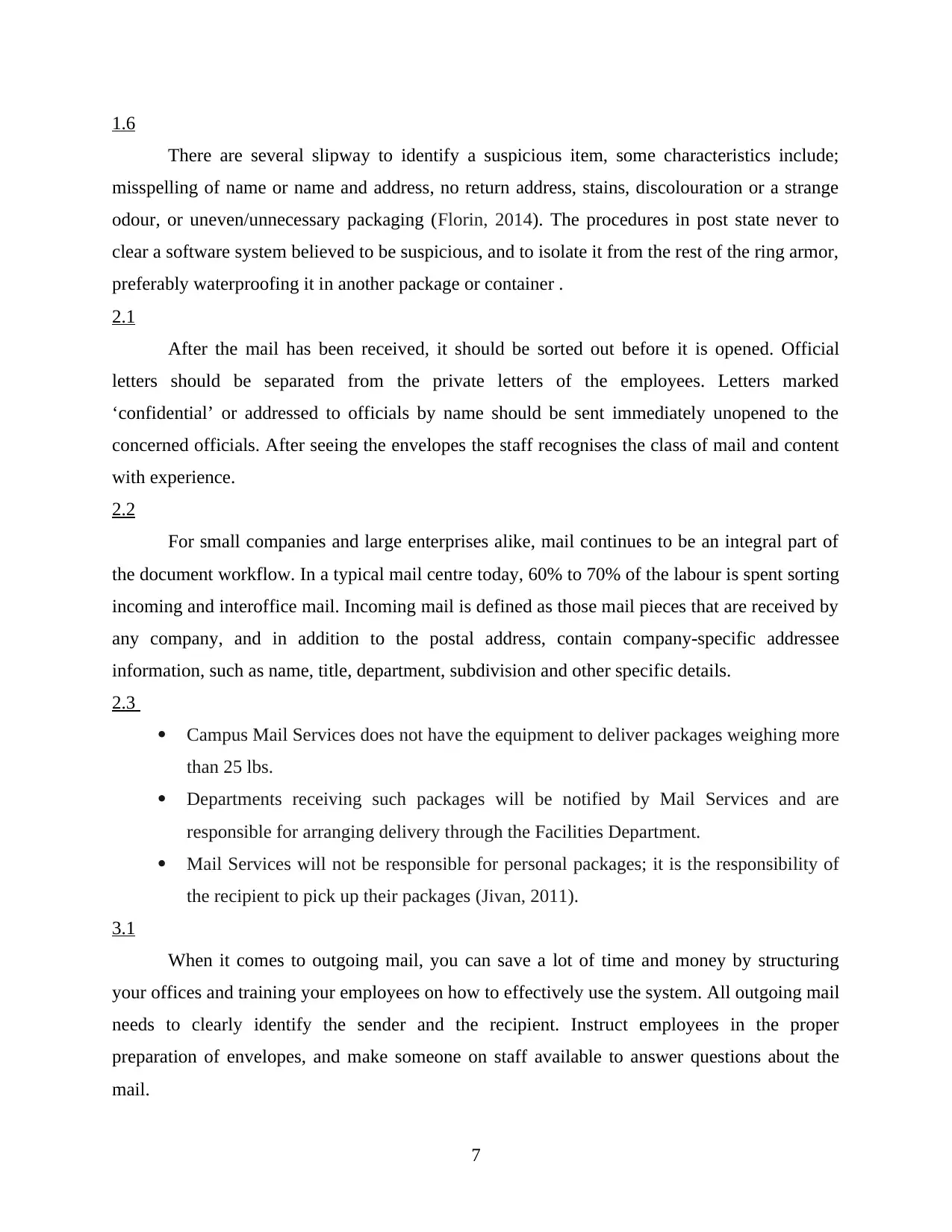
1.6
There are several slipway to identify a suspicious item, some characteristics include;
misspelling of name or name and address, no return address, stains, discolouration or a strange
odour, or uneven/unnecessary packaging (Florin, 2014). The procedures in post state never to
clear a software system believed to be suspicious, and to isolate it from the rest of the ring armor,
preferably waterproofing it in another package or container .
2.1
After the mail has been received, it should be sorted out before it is opened. Official
letters should be separated from the private letters of the employees. Letters marked
‘confidential’ or addressed to officials by name should be sent immediately unopened to the
concerned officials. After seeing the envelopes the staff recognises the class of mail and content
with experience.
2.2
For small companies and large enterprises alike, mail continues to be an integral part of
the document workflow. In a typical mail centre today, 60% to 70% of the labour is spent sorting
incoming and interoffice mail. Incoming mail is defined as those mail pieces that are received by
any company, and in addition to the postal address, contain company-specific addressee
information, such as name, title, department, subdivision and other specific details.
2.3
Campus Mail Services does not have the equipment to deliver packages weighing more
than 25 lbs.
Departments receiving such packages will be notified by Mail Services and are
responsible for arranging delivery through the Facilities Department.
Mail Services will not be responsible for personal packages; it is the responsibility of
the recipient to pick up their packages (Jivan, 2011).
3.1
When it comes to outgoing mail, you can save a lot of time and money by structuring
your offices and training your employees on how to effectively use the system. All outgoing mail
needs to clearly identify the sender and the recipient. Instruct employees in the proper
preparation of envelopes, and make someone on staff available to answer questions about the
mail.
7
There are several slipway to identify a suspicious item, some characteristics include;
misspelling of name or name and address, no return address, stains, discolouration or a strange
odour, or uneven/unnecessary packaging (Florin, 2014). The procedures in post state never to
clear a software system believed to be suspicious, and to isolate it from the rest of the ring armor,
preferably waterproofing it in another package or container .
2.1
After the mail has been received, it should be sorted out before it is opened. Official
letters should be separated from the private letters of the employees. Letters marked
‘confidential’ or addressed to officials by name should be sent immediately unopened to the
concerned officials. After seeing the envelopes the staff recognises the class of mail and content
with experience.
2.2
For small companies and large enterprises alike, mail continues to be an integral part of
the document workflow. In a typical mail centre today, 60% to 70% of the labour is spent sorting
incoming and interoffice mail. Incoming mail is defined as those mail pieces that are received by
any company, and in addition to the postal address, contain company-specific addressee
information, such as name, title, department, subdivision and other specific details.
2.3
Campus Mail Services does not have the equipment to deliver packages weighing more
than 25 lbs.
Departments receiving such packages will be notified by Mail Services and are
responsible for arranging delivery through the Facilities Department.
Mail Services will not be responsible for personal packages; it is the responsibility of
the recipient to pick up their packages (Jivan, 2011).
3.1
When it comes to outgoing mail, you can save a lot of time and money by structuring
your offices and training your employees on how to effectively use the system. All outgoing mail
needs to clearly identify the sender and the recipient. Instruct employees in the proper
preparation of envelopes, and make someone on staff available to answer questions about the
mail.
7
⊘ This is a preview!⊘
Do you want full access?
Subscribe today to unlock all pages.

Trusted by 1+ million students worldwide
1 out of 27
Related Documents
Your All-in-One AI-Powered Toolkit for Academic Success.
+13062052269
info@desklib.com
Available 24*7 on WhatsApp / Email
![[object Object]](/_next/static/media/star-bottom.7253800d.svg)
Unlock your academic potential
Copyright © 2020–2025 A2Z Services. All Rights Reserved. Developed and managed by ZUCOL.





